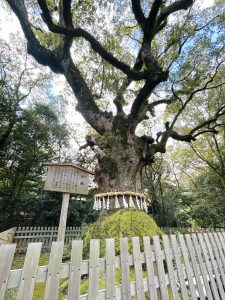熱田神宮の大楠に住むといわれる蛇(愛知県名古屋市千種区姫池通 骨董買取 古美術風光舎)
2025.01.11
昨日、熱田神宮へ遅ればせながら初詣に行ってまいりました。何度も訪れているのに全く知らなかったのですが、手水舎の横の大楠の木には昔から蛇が住んでいるとの話を聞き、改めて繁々と眺めてまいりました。大楠には蛇にまつわる説明などは書かれていませんが、立て札に「この楠は弘法大師お手植えとも伝えられ、樹齢は千年以上といわれている」と書かれており、それだけで有難い気持ちになります。
蛇が今も住んでいるのかどうか定かではなかったのですが、卵が供え物として置かれていたこともあり遭遇すると縁起がよいと言われています。ご神木の上の方にも祠が置かれているのが見えました。

熱田神宮は三種の神器のひとつである草薙の剣が祀られています。草薙の剣には蛇に関する伝説も多いそうで、巳年の本年に蛇が住むという大楠に手を合わせてみてはいかかでしょうか。
さて本日1月11日は鏡開きですね。鏡餅は元旦にお迎えした年神様の居場所であり、その魂が宿る依代とされています。
その辺りは親から教えてもらった記憶がありますが、なぜ鏡開きをするのか…。いつものごとく深く考えもせずお餅をいただいていましたので少し調べてみました。
古来日本では、人の魂は元日に更新されるという考え方があり、年神様が宿った鏡餅を開いて頂くことによりその力を体にとり込むという意図があります。なぜ「鏡」がつくのかというと、鏡が三種の神器として伊勢神宮をはじめとする神社に祀られているからだとされています。鏡はこの世とあの世の境界として神事に用いられたり、神話の中で太陽の神様とされる天照大神の御神体として祀られます。昔の鏡は銅鏡で丸い形をしていました。
一説によりますと、餅は八咫鏡(やたかがみ)、橙は八尺瓊勾玉(やさかにのまがたま)、串柿は草薙の剣と鏡餅の飾りは三種の神器を表しているとも言われているそうです。
鏡餅は平安時代には既に存在していたようで、「源氏物語」にも記述があります。2段重ねになっているのは、陰と陽、月と太陽を表しているという説もあり、万物は陰と陽の相互作用により成り立つという中国の陰陽思想に基づいているとされています。
そしてもう一つ興味深いお話を見つけました。
鏡餅には年神様の魂である「年魂(としだま)」が宿っており、鏡開きでその年魂を家長が家族に分け与え、それを食べることにより一年を無事に過ごせますようにという願いを込めていたのこと。
もうお気づきでしょうが、この「年魂」が年始に配る「お年玉」の起源だそうです。元々は鏡餅を与えていたものが、江戸時代頃からお金に変わっていきました。
ちなみに鏡餅は包丁で切ってはならず、木槌などで割らないといけないとか。なかなか難しそうですよね。
スッタフH、例年なら紅白歌合戦を観た後に除夜の鐘を聞きながら(最近はあまり聞こえてきませんね)近所の天満宮を参拝するのが恒例でした。人混みに押されながら参拝することに醍醐味を感じていましたが、今では紅白を最後まで観るのもきつくなり、見終えた達成感と共にすぐに眠りにつきます。
初詣も人混みを避けて15日までに参拝すればいいかという呑気な心持ちで、昨日の初詣となりました。
午前中は雪が降っていて外出するのを躊躇しましたが、さすがにそろそろ参らなければと思い向かった熱田神宮。いつも清々しい場所ですが、雪のあとは更に澄んだ空気に包まれており、気持ちが引き締まりました。
それでは、また次の機会に。
Yesterday, I paid a belated visit to Atsuta Jingu Shrine for the first time. Although I have been to the shrine many times, I had no idea that snakes have been living in the camphor tree next to the hand-watering basin for a long time, and I looked at the camphor tree again with great interest. There is no explanation about the snake on the camphor tree, but a sign says, “This camphor tree is said to have been planted by Kobo Daishi and is said to be over 1,000 years old,” which made me feel grateful.
I was not sure if snakes still live in the tree, but it is said that it is good luck to encounter one, as eggs were once placed as an offering. A shrine was also placed at the top of the sacred tree.
Atsuta Jingu Shrine enshrines the Sword of Kusanagi, one of the three sacred weapons. The sword is said to have many legends about snakes, so why don’t you join hands with the camphor tree where snakes are said to live in this year of the Snake?
Today, January 11, is Kagamibiraki. Kagamimochi is the place for the New Year’s god who was welcomed on New Year’s Day, and it is believed to be a yorishiro, a place where the god’s spirit resides.
I remember learning about this from my parents, but why do we have Kagamibiraki? As usual, I had been receiving rice cakes without giving it much thought, so I did a little research.
In ancient Japan, there is a belief that a person’s soul is renewed on the first day of the year, and by opening and eating the Kagamimochi, in which the New Year’s god resides, the person intends to take its power into his or her body. The reason why the word “Kagami” is used is because mirrors are enshrined in shrines such as the Ise Jingu Shrine as one of the three sacred treasures. Mirrors are used in Shinto rituals as a boundary between this world and the next, and are also enshrined as the sacred object of Amaterasu, the sun god in mythology. In ancient times, mirrors were bronze and round in shape.
According to one theory, the rice cake represents the Yatagami, the orange the Yasakani no Magatama, and the persimmon the Kusanagi no Tsurugi (sword of Kusanagi), and the decorations of the Kagamimochi represent the three sacred objects.
Kagamimochi already existed in the Heian period (794-1185), and is mentioned in “The Tale of Genji (Genji Monogatari),” and some say that the two-layered decoration represents yin and yang, the moon and the sun, and is based on Chinese yin-yang philosophy that all things are composed of the interaction of yin and yang.
I also found another interesting story.
Kagamimochi contains “Toshidama,” the spirit of the New Year’s god, and at Kagamibiraki, the family head of the family shares the Toshidama with his family, hoping that the family will spend the year safely by eating it.
As you may have already noticed, this “Toshikama” is said to be the origin of the “New Year’s gift” given out at New Year’s. Originally, Kagamimochi (mirror-shaped rice cakes) were given to the family. Originally, Kagamimochi (mirror-shaped rice cakes) were given as New Year’s gifts, but around the Edo period (1603-1867), they were replaced by money.
By the way, Kagamimochi must not be cut with a knife, but must be broken with a mallet or something. It sounds quite difficult, doesn’t it?
Usually, after watching the Kohaku Uta Gassen, I would visit the nearby Tenmangu Shrine while listening to the bell tolling the New Year’s bell (you don’t hear it very often these days). I used to feel real pleasure in visiting the shrine while being pushed by the crowds, but now it is hard to watch Kohaku all the way through, and I immediately fall asleep with a sense of accomplishment after watching the show.
I was so optimistic that I would be able to visit the shrine by the 15th to avoid the crowds, that I decided to pay my first visit to the shrine yesterday.
I hesitated to go out because it was snowing in the morning, but I decided it was time to go to Atsuta Jingu Shrine. It is always a refreshing place to visit, but after the snow, the air was even clearer and I felt more relaxed.
See you next time.
*****************
ご実家の整理やお片付けなどをされている方のご相談などが多くございます。
お片付けなどくれぐれもご無理のないようになさってくださいませ。
風光舎では古美術品や骨董品の他にも絵画や宝石、趣味のお品など様々なジャンルのものを買受しております。
お片付けをされていて、こういうものでもいいのかしらと迷われているものでも、どうぞお気軽にご相談下さいませ。
また風光舎は、出張買取も強化しております。ご近所はもちろん、愛知県内、岐阜県、三重県その他の県へも出張いたします。
まずは、お電話お待ちしております。
愛知県名古屋市千種区姫池通
骨董 買取【古美術 風光舎 名古屋店】
TEL052(734)8444
10:00-18:00 OPEN
#出張買取#骨董#古美術#骨董品#絵画#版画#茶道具#刀剣#彫刻

